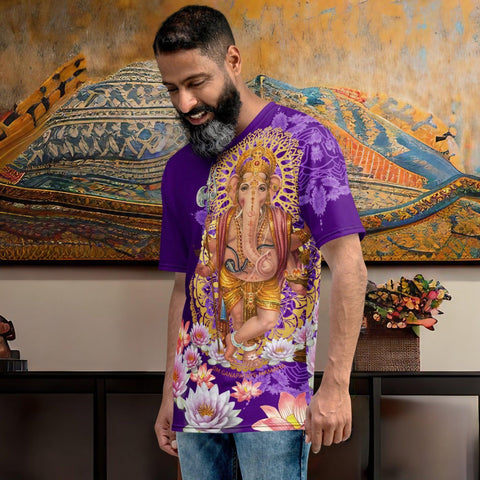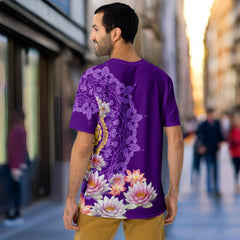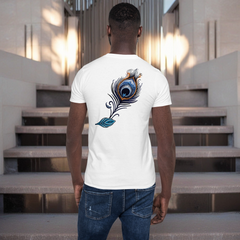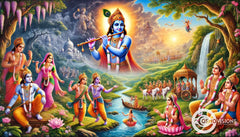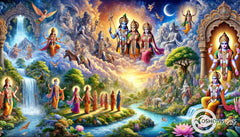Traditional Hindu Clothing - Exploring Religious Attire in India and Beyond
Posted by Massimiliano Geraci

Hindu clothing is rich in history and meaning. The sari, a bright fabric wrapped around the waist and paired with a tight blouse called a choli, showcases the beauty of Indian women. The historical significance of the sari and other garments dates back to ancient India, where specific fabrics, weaving techniques, and dyeing methods were developed.
For comfort and elegance, a salwar kameez combines a long tunic with loose trousers. These clothes go beyond fashion; they carry tradition in every fold. The influence of the Hindu religion is evident in traditional clothing practices, such as wearing bindi, bangles, and henna body art. Hindu men also dress to express their faith, wearing dhotis or lungis tied around their waists for daily wear or special occasions like weddings.
Clothing in Hindu culture does more than cover the body; it tells stories of spirituality and community. The bhindi on the forehead, bangles on the wrists, and henna decorating hands and feet are not just adornments but symbols of marital status, health, and happiness.
Each piece worn by Hindu women has deep roots in ancient traditions that continue to influence modern styles across India. Men’s apparel varies too, but they always respect the heritage from which it came—be it through simple white cotton garments or elaborate silk tunics during festivals.
What Are the Main Types of Hindu Clothing?
Men in Hindu culture often wear traditional attire like Achkan/Sherwani, Bandhgala, Lungi, and Kurta. These items signal a man’s caste, class, and the region he comes from within the Indian subcontinent. Turbans are also crucial pieces that carry deep cultural and religious meanings.
Women have their own traditional clothing, which includes saris, salwar kameez, and various forms of jewelry, such as bangles and bhindi. Saris drapes elegantly around the body, while salwar kameez offers modesty with style. Traditional garments like the Mekhela Sador in Assam, Mundum Neriyathum in Kerala, and Rignai in Tripura highlight the diverse attire across the Indian subcontinent.
When visiting temples or attending religious ceremonies, women prefer wearing these traditional outfits to reflect respect for their spirituality. Clothing is more than fashion; it expresses culture and identity.
Popular Garments Hindu Men Wear
Hindu men’s clothing is rich in tradition and varies widely across different regions. These garments often symbolize the wearer’s social status, regional identity, and spiritual beliefs. The draping and wrapping of garments like dhotis and lungis are part of the traditional Indian style, reflecting various regions' cultural practices and influences.
-
Dhoti: A long cloth wrapped around the waist and legs, then knotted at the waist. Traditionally, white or cream is a typical attire for religious ceremonies and everyday wear in many parts of India.
-
Kurta: A loose collarless shirt that falls just above or below the knees. It pairs well with a dhoti for religious events or pants for casual wear. The kurta reflects simplicity and comfort and comes in various colors, often adorned with embroidery.
-
Sherwani: A more formal garment resembling a coat, fastened in the front with buttons. It extends to just below the knees and is worn over a kurta with trousers called churidars during special occasions like weddings.
-
Achkan/Sherwani: This attire features a similar design to the sherwani but is slightly shorter. It is also worn during formal events. This attire showcases the blend of tradition with elegance.
-
Profusion of Turbans: Indian turbans—pagri and safa—vary by color, fabric, and style across regions. They represent the wearer’s caste, region, and social status within Hindu society.
-
Lungi: A sarong-like garment tied around the waist, common in South India for daily wear due to its comfort in hot climates.
-
Angarkha: An overlapping jacket favored in ancient times and continues to be worn at traditional functions today. It ties at the side and is admired for its aesthetic appeal and functionality.
-
Bandhgala: Also known as Jodhpuri suits for men, it combines traditional Indian styles with Western suit tailoring, signifying prestige and elegance at celebrations.
Each clothing piece carries deep cultural significance beyond its material value; they tell stories of heritage, spirituality among Hindus, regional pride, and evolving fashion trends while respecting religious customs.

Essential Attire for Hindu Women
Hindu women wear various garments that are rich in color and tradition. These clothes are not just attire but reflect cultural pride and spiritual symbolism. The use of primary colors in traditional clothing, including dyeing fabrics, plays a significant role in these garments, highlighting their historical and cultural importance.
-
The sari stands out as the most recognized piece among Hindu women. This brightly colored fabric, often adorned with intricate designs, wraps around the waist and drapes over the shoulder. It pairs with a tight blouse called a choli. Wearing a sari is an art passed down through generations, symbolizing grace and elegance.
-
Another essential outfit is the salwar kameez, comprising a long tunic top (kameez) and loose-fitting pants (salwar). This ensemble offers comfort without sacrificing style, making it popular for daily wear and special occasions.
-
The bhindi, or bindi—a red dot worn between the eyes—carries deep significance. It represents wisdom and spiritual sight, serving as an essential accessory for Hindu women.
-
Bangles decorate the wrists of many Hindu women. These circular ornaments signify marital status but have become a fashion statement among all ages, adding color and music to movements.
-
Henna body art adorns hands and feet in intricate patterns on festive occasions like weddings. Known as mehndi, this temporary skin decoration signifies joy, beauty, and good luck.
Each item carries historical significance and showcases the rich tapestry of Hindu culture across different regions of India. They blend spirituality with everyday life, allowing wearers to express their beliefs outwardly while paying homage to centuries-old traditions.

Differences in Regions of India
The vibrant tapestry of India’s culture weaves in a diverse array of traditional attire, reflecting a rich heritage and regional uniqueness. This diversity becomes even more apparent as we explore the conventional Hindu clothing varying from one region to another, each piece telling its own story of spirituality, tradition, and beauty.
Traditional clothing also varies among different religious groups within India, with religious observance playing a significant role in personal appearance. For instance, Hindu men may wear a tilak and a janeu, traditional symbols of piety and associated with the priestly caste.
RegionTraditional Attire for WomenTraditional Attire for MenKeralaMundum NeriyathumTraditional MunduAssamMekhela Sador, Riha, RignaiDhoti and KurtaPunjabSalwar KameezPagri and KurtaRajasthan & GujaratGhagra Choli with mirror embellishmentsDhoti, Kurta, and Bandhani turbansTamil Nadu Kanchipuram Silk SariVeshti with Angavastram
Each piece of clothing serves as a mark of identity and an expression of spiritual and cultural beliefs. From the luxurious Kanchipuram silk saris of Tamil Nadu to the elegant Mundum Neriyathum of Kerala, and the vibrant Ghagra Cholis of Rajasthan and Gujarat, traditional Indian attire showcases the country’s diversity. Men, too, display regional pride through their choice of dress, from the dhotis and kurtas of Assam to the colorful turbans of Rajasthan and Gujarat.
These garments tell tales of historical significance, carry the weight of cultural importance, and influence modern fashion trends. The detailed craftsmanship and fabric choice often speak to the region’s geography, climate, and local customs, making traditional Hindu clothing a subject rich in diversity and significance.
How Does Hindu Religious Clothing Reflect Spirituality?
Colors play a huge role in Hindu spirituality, each carrying deep meanings. Saffron stands out, symbolizing purity and renunciation. People wear it to show their search for light over darkness.
This choice reflects a major spiritual journey, just by the act of choosing certain colors to wear. White shows peace and purity, often worn at funerals to express mourning in a serene way.
Traditional marks like the tilak serve as powerful symbols too. Placed between the eyebrows, this mark represents one's third eye — the focus on inner wisdom over physical sight.
Accessories such as bangles and bhindi carry historical significance, grounding wearers in their culture while pointing to spiritual truths beyond themselves.
Clothing is not just about covering our bodies; it's a declaration of our journey towards enlightenment.
Next, we'll explore traditional Indian clothing pieces for women.
-Symbolism of Colours
Colors in Hindu clothing carry deep meanings. The sari, worn with vibrant hues, tells a rich story of tradition and identity. Each color holds a special significance. For example, red symbolizes love and courage.
It’s often seen at weddings where brides wear this lively shade to start their new journey.
The bhindi, a red dot worn between the eyes, stands for wisdom and marks marital status among women. Mehndi decorates hands and feet with detailed patterns during special events like weddings.
These designs are not just for beauty; they also hold symbolic meanings, such as blessings for the couple or protection from evil spirits.
In these traditions, colors do more than look pretty. They link people to their faith and community through every thread and dye used in their clothing.
Religious Significance of Saffron Attire
Saffron attire stands as a powerful symbol in Hinduism. It represents fire, purity, and religious abstinence. Monks and sages wear saffron robes to seek spiritual enlightenment, shunning material desires.
This color guides them on their path to wisdom and liberation from the cycle of birth and death.
The choice of saffron also reflects sacrifice and the quest for light in darkness. Devotees wear this sacred color during important festivals like Diwali and Navratri. It reminds them of the eternal truths of Hindu scriptures such as the Vedas, Puranas, and Upanishads.
Through wearing saffron attire, Hindus connect deeply with their divine heritage and cosmic principles governing life.
Role of the Tilak in Hinduism
The tilak holds a special place in Hinduism. People use sandalwood or vermillion to mark it between the eyebrows. This mark serves as a symbol of spiritual sight and shows devotion to God.
It varies by sect, with different designs pointing to beliefs and deities like Vishnu or Shiva.
Men and women wear the tilak during ceremonies and festivals. It reminds them of their faith's teachings and connects them deeply with their culture. The tilak is not just a dot on the forehead; it is an expression of one’s inner faith made visible.
Next, let’s explore traditional Indian clothing pieces for women.
What Are the Traditional Indian Clothing Pieces for Women?
Women in India wear several traditional outfits that show their culture's beauty and depth. The sari stands out as a symbol of elegance. It is a long piece of cloth wrapped around the body uniquely, showcasing patterns and colors that tell stories of heritage and tradition.
Each region has its way of draping a sari, making it a versatile garment throughout history.
Another essential outfit is the salwar kameez, consisting of loose pants (salwar) paired with a tunic top (kameez). This attire blends comfort with style, offering women ease while maintaining modesty according to Hindu guidelines on dressing for temple visits or daily life.
Additions like the bhindi (a decorative mark worn on the forehead), bangles, and henna body art enrich these traditional outfits further, connecting wearers to centuries-old customs and spiritual practices.
The Sari: Elegance Personified
Saris shows the beauty of Hindu attire, shining in colors and patterns. Each piece wraps around the body and is paired with a choli. This dress is more than cloth; it's art worn by women across India.
From Sambalpuri to Banarasi, every region has its style.
A sari connects tradition with fashion, weaving stories of heritage in every pleat.
Different saris like Mysore silk and Kanchipuram carry unique tales from their origins. They blend texture and dyeing skills to create masterpieces that grace festivals and daily life.
Saris are not just clothing; they symbolize India's rich tapestry of culture and spirituality woven through time.
About the Salwar Kameez
The Salwar Kameez is a classic dress code for Hindu women. It teams a long shirt (kameez) with wide-leg pants (salwar). This outfit stands out in India and other places for its comfort and style.
Women of various ages wear it. The Salwar Kameez's versatility makes it suitable for daily tasks, work, and special events like weddings.
This attire showcases regional styles throughout India. Craftspeople make it from silk, cotton, or wool and add beautiful designs with embroidery or printing techniques.
Colors vary widely, but each one holds meaning in Hindu culture. Next up is the versatile kurta, which is popular among traditional Indian clothing pieces for women.
The Versatile Kurta
Just as the Salwar Kameez offers a blend of comfort and style, the Kurta stands out for its versatility. This traditional attire adapts to many occasions, from daily wear to special events.
Men and women find elegance and ease in wearing cotton, silk, or linen kurtas. These fabrics keep the wearer cool in India's warm climate while offering a canvas for beautiful prints or intricate embroidery.
Kurtas pair well with different types of bottoms, such as dhotis, pyjamas, or churidars, allowing one to mix and match according to the event or personal preference. The designs vary across regions, showcasing India's rich cultural tapestry through clothing.
For religious ceremonies or festivals, people often choose kurtas with elaborate decorations. On regular days, simpler versions serve as comfortable attire that reflects Indian heritage and artistry.
Every piece tells a story of tradition, meeting modern needs while maintaining spiritual significance through colors such as saffron for purity and devotion.
What Is the Typical Hindu Wedding Attire?
Hindu brides often choose the sari for their wedding day. This elegant piece wraps around the waist, with pleats and a draped end over the shoulder, revealing beauty and tradition in every fold.
They pair it with an underskirt or petticoat and a short blouse known as choli, creating a timeless look that honors centuries of customs. The salwar kameez offers another popular option, featuring a long tunic called the kameez over loose-fitting pants known as salwar.
This outfit blends comfort with ceremonial grace.
Men at Hindu weddings traditionally wear outfits like sherwanis or kurta pajamas, reflecting regional styles across India. These garments speak to personal taste and embody deep cultural significance, showcasing vibrant colors and intricate patterns passed down through generations.
In every thread of traditional Hindu wedding attire lies a story—an intricate tale of spirituality, culture, and love.
Bridal Wear for Hindu Women
Saris shines as the top choice for Hindu brides across India. Each region weaves its own story through these elegant pieces of cloth, making a bride’s attire profoundly personal and rich in heritage. Similarly, Sikh women follow traditional practices such as wearing a turban and other traditional attire, reflecting their cultural and religious identity.
In Rajasthan and Gujarat, women often choose the Ghagra Choli for their special day. This garment adds color and tradition to wedding ceremonies, blending perfectly with Sikh customs.
In Assam, brides wear something different called the Sador. This three-piece dress carries unique significance within its threads, connecting the wearer to Assamese culture on her wedding day.
From vibrant saris to detailed Ghagras and meaningful Sadors, bridal wear in Hindu traditions holds beauty beyond just fabric—it embraces history, spirituality, and regional identity with every stitch.
Traditional Dress for Hindu Men at Weddings
Hindu men wear special clothes for weddings. They wear a dhoti, kurta, and Nehru jacket. A turban or pagdi is also part of this dress. These clothes show the rich customs of Hindu weddings.
Colors and designs mean different things in the ceremony.
The clothing reflects the beauty and diversity of Hindu traditions. It is very detailed and focuses on culture. Men's wedding attire changes with region. Some also wear dupattas, sherwanis, and jootis for shoes at their weddings.
Regional Variations in India
India's vast land embraces diversity, especially in traditional attire. Regional variations highlight the country's rich culture and spiritual depth.
-
In Punjab, men and women wear vibrant Phulkari dupattas and turbans. These colorful textiles symbolize joy and prosperity.
-
Kerala boasts the Kasavu saree, mainly white with a golden border, reflecting simplicity and purity.
-
Rajasthan is famous for its bright Bandhani tie-dye fabrics. Women wear these lively printed saris, while men sport headgear called Pagris.
-
Assam takes pride in Mekhela Chador, a two-piece silk ensemble representing elegance. Women adorn themselves with traditional jewelry.
-
West Bengal’s Jamdani saris are known globally for their intricate designs and fine craftsmanship.—This handwoven textile tells tales of heritage and skill.
-
Tamil Nadu prefers brightly colored Kanjeevaram saris made from heavy silk for special occasions like weddings and festivals.
-
In urban areas of India, a blend of Western wear influences daily attire, but traditional clothing dominates during religious ceremonies and festivals.
-
Gujarati clothing includes the Ghagra-Choli, adorned with mirror work. This garment displays an affection for detail and vibrancy. Familiar during celebrations, it showcases local artistry at its best.
Each region uses unique fabrics, stitching styles, and decorative elements to create garments that are not just clothing but a celebration of identity and tradition.
Make-Up & Accessories
In Hindu culture, make-up, and accessories like bindi, bangles, and henna body art hold deep meanings. The bindi, a red mark worn on the forehead, signals both marital status and religious significance for women. In contrast, Muslim women often wear headscarves such as the hijab, niqab, or burqa, which also carry deep religious and cultural significance, differing from the practices of Hindu women.
It’s a critical decoration that serves as more than just beauty—it marks essential life stages. Bangles are not left behind; originally symbols of marriage, young and unmarried girls now wear them as fashion statements while still respecting their cultural roots.
Henna body art, known as mehndi, adorns the hands and feet of women during celebrations such as weddings. These artistic designs are more than decorations—prayers for luck, happiness, and love painted onto the skin. Accessories like henna embody wishes for joy and prosperity. Each piece tells its own story—bindis symbolize wisdom; bangles represent health and fortune; mehndi captures fleeting moments of joy through intricate designs that fade over time but leave lasting memories.
Together, they form an essential part of Hindu attire that goes beyond mere appearance to deeply rooted spiritual expressions.

The Bhindi
The bindi is a small, decorative mark that Hindu and Buddhist women often wear on their forehead. It's tied to both marital status and spirituality. About 84% of Hindu and 78% of Buddhist women choose to adorn themselves with a bindi, showcasing its deep cultural significance.
This small mark holds vast meanings across different regions in India, reflecting beliefs about energy, the third eye, and one's connection to the divine.
Wearing a bindi goes beyond simple decoration; it represents a woman’s strength and place within spiritual traditions. The practice connects back to ancient times, linking today’s wearers with generations past.
This continuity enriches India's diverse tapestry of customs and beliefs. As we move from this symbol to discussing bangles, another critical piece in traditional Hindu attire...
Bangles
Bangles shine bright in Hindu culture, catching the eye with their beauty and deep meaning. From young girls to women yet to marry, bangles adorn wrists across India. These circular ornaments come in many forms, from simple loops to intricate designs decked out with gems.
Each piece tells a tale of tradition, woven into the fabric of daily life and grand celebrations.
Crafting these bangles takes skill and creativity. Artisans pour their hearts into making each set unique, using materials that range from gold and silver to glass and plastic. The choice of material often reflects the wearer's status or the occasion it's meant for.
During festivals and weddings, wrists sparkle more than usual, with banded arrays of color adding an extra layer of joy to already vibrant events. In this way, bangles are not just accessories but vital cultural expression among Hindus in India and beyond.
Henna Body Art
Henna body art, or mehndi, comes to life in vibrant designs on the skin of Hindu women during special times like weddings. Artists make the paste by drying and grinding henna leaves into fine dust.
This tradition dresses hands and feet in intricate patterns that symbolize joy, beauty, and spiritual awakening. The art form goes beyond mere decoration; it's a sacred ritual woven into the fabric of Hindu celebrations.
Creating these designs requires skill and patience as each line tells part of a larger story of life, love, and devotion. As this ancient craft meets modern aesthetics, it continues to be an essential expression of cultural identity for people around the globe.
Now, let's explore why traditional Hindu clothing holds such significance.
Why Is Traditional Hindu Clothing Important?
Traditional Hindu clothing holds deep roots in history and culture. It is a mirror reflecting centuries of tradition, religious practices, and ceremonies. From the vibrant colors of Sari and Salwar Kameez to the elegance of Sherwanis, these garments weave together stories from ancient times.
They tell tales of dyeing techniques, trade, and textile production that date back thousands of years. This attire showcases Indian artistry and connects wearers to their ancestors.
This clothing carries meanings beyond its fabric. Colors like saffron represent purity and sacrifice in Hinduism, while jewelry such as Bindis signify wisdom. At weddings, brides adorn themselves in red for prosperity as they start their new lives.
During rituals, men wear traditional tunics and trousers to honor deities like Krishna and Ganesha. These styles have evolved yet continue to influence modern fashion trends globally, blending Western designs with Subcontinental flair in urban areas across India.
This fusion highlights how traditional Hindu clothing remains relevant today, bridging the past with the present.
Historical Significance of Hindu Clothing
Hindu clothing carries deep historical roots, shaping the identity and spirituality of its people. For centuries, garments like the sari and salwar kameez have cloaked Hindu women in grace and modesty.
These clothes are more than fabric; they're a whisper from the past, speaking of tradition and continuity. The bhindi marks married women with a significant dot, symbolizing marital status and the spiritual third eye.
Bangles clink on the wrists of brides, echoing tales of devotion and duty.
Mehndi adorns hands during celebrations, painting stories of joy with every intricate design. In temples or during sacred ceremonies, women wear long skirts, as advised by tradition to honor modesty.
Some cover their heads with scarves on memorable moments, embracing a practice that ties them back to ancient customs. Every thread woven into Hindu attire is stitched with history's hand, offering glimpses into lives lived long ago yet still pulsating in today's cultural heartbeat.
Cultural Importance in Various Regions of India
Traditional clothes in different parts of India tell stories of history, spirituality, and pride. The sari changes form from the Sambalpuri Saree in Odisha to the Banarasi in Varanasi, each weaving a tale of local myths and practices.
Men's attire is just as telling. The Dhoti worn in Tamil Nadu speaks to simplicity and comfort essential for the warm climate, contrasting with the Sherwani seen at North Indian weddings, which symbolizes grandeur.
Regions have unique pieces like the Mekhela Sador in Assam and Ghagra Choli in Rajasthan, highlighting India's diversity. These garments carry centuries-old designs that have traveled through time.
They hold a mirror to societal values where colors like saffron represent purity and courage. Wearing these dresses goes beyond fashion—connecting with one's roots and acknowledging a shared cultural heritage that spans rural areas to bustling cities.
Impact on Modern Fashion Trends
Traditional Hindu clothing, such as the sari and salwar kameez, has changed modern fashion. Designers now mix these old styles into their new collections. The look of jeans and t-shirts for Hindu women shows how old and new can blend to fit today's life.
Bhindi, bangles, and henna art have gone beyond Hindu culture. People around the world wear them as modern fashion accessories. This mix shows how different cultures learn from each other to create unique styles.
How Has Western Clothing Influenced Hindu Religious Clothing?
Western fashion has entered Hindu religious clothing, especially in urban areas. Jeans and T-shirts have become common, showing a shift toward less formal attire among Hindu women.
This change is most visible among those who live in Western countries or cities influenced by Western culture. The simplicity and comfort of Western clothes appeal to many.
The bhindi and bangles tell another story of this influence. Once markers of marital status for Hindu women, they are now widespread even among the young and unmarried. This shows how traditional symbols can find new meanings over time.
Wearing these items with jeans or other casual Western attire combines old traditions with modern trends.
Western Styles in Urban Areas
In urban areas, people mix traditional Indian clothing with Western fashion. This creates a stylish look that keeps Indian culture alive while embracing modern trends. Trousers and shirts, once seen as purely Western wear, now count as traditional dress in India.
Bollywood movies show these fashions, too. They help make the new style famous all over India.
The Swadeshi movement played a significant role here. It pushed for wearing clothes made in India only. Yet, urban Indians found a way to blend this idea with Western styles. The government of India supports this mix by accepting trousers and shirts as part of official Indian dress code now.
Changes in Daily Attire
Western styles have started mixing with traditional Hindu clothing. Many people in cities wear jeans, T-shirts, and dresses every day. But they still hold onto their heritage during festivals and weddings by wearing saris, salwar kameezes, and bindis.
These modern changes reflect a blend of cultures.
Young Hindu women now wear the bindi as a fashion statement, not just as a symbol of marriage. Bangles also have taken on new meanings beyond marital status. They add color and style to any outfit, showing how traditions evolve yet keep their roots.
Henna body art remains popular for special events like weddings, embracing its historical importance while allowing creativity to flourish in designs.



